Karyorrhexis - Study guides, Class notes & Summaries
Looking for the best study guides, study notes and summaries about Karyorrhexis? On this page you'll find 171 study documents about Karyorrhexis.
Page 4 out of 171 results
Sort by
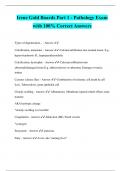
-
Irene Gold Boards Part 1 - Pathology Exam with 100% Correct Answers
- Exam (elaborations) • 41 pages • 2024
- Available in package deal
-
- $13.49
- + learn more
Irene Gold Boards Part 1 - Pathology Exam with 100% Correct Answers Types of degeneration... - Answer ️️ - Calcification, metastatic - Answer ️️ -Calcium infiltration into normal tissue. E.g. hypervitaminosis D., hyperparathyroidism Calcification, dystrophic - Answer ️️ -Calcium infiltration into abnormal/damaged tissue E.g. atherosclerosis or atheroma. Damage to tunica intima Caseous (cheese like) - Answer ️️ -Combination of ischemic cell death & cell lysis. Tuberculosi...
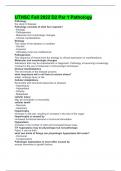
-
UTHSC Fall 2022 D2 Par 1 Pathology
- Exam (elaborations) • 21 pages • 2024
-
- $10.49
- + learn more
UTHSC Fall 2022 D2 Par 1 Pathology Pathology the study of disease Pathology consists of what four aspects? - Etiology - Pathogenesis - Molecular and morphologic changes - Clinical manifestations Etiology The cause of the disease or condition - Genetic - Acquired - Ultimately most are multifactorial Pathogenesis The sequence of events from the etiology to clinical expression or manifestations Molecular and morphologic changes Alterations that may be characteristic or diagnostic. P...
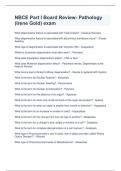
-
NBCE Part I Board Review- Pathology (Irene Gold) exam
- Exam (elaborations) • 8 pages • 2023
-
Available in package deal
-
- $11.49
- + learn more
What degenerative feature is associated with Tuberculosis? - Caseous Necrosis What degenerative feature is associated with albuminous membrane injury? - Cloudy Swelling What type of degeneration is associated with Infarction (MI) - Coagulation Where is enzymatic degeneration most often seen? - Pancreas What does liquefaction degeneration effect? - CNS or Skin What does Wallerian degeneration effect? - Peripheral nerves. Degenerates to the Node of Ranvier. What occurs due to Zen...
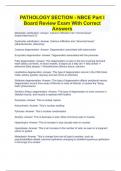
-
PATHOLOGY SECTION - NBCE Part I Board Review Exam With Correct Answers
- Exam (elaborations) • 23 pages • 2024
-
- $8.49
- + learn more
Metastatic calcification -Answer Calcium infiltration into *normal tissue* (Hypervitaminosis D) Dystrophic calcification -Answer Calcium infiltration into *abnormal tissue* (atherosclerosis, atheroma) Caseous degeneration -Answer Degeneration associated with tuberculosis Enzymatic degeneration -Answer Degeneration associated with the pancreas Fatty degeneration -Answer This degeneration is seen in the liver (nutmeg liver)and heart (tabby cat heart). In blood vessels, it begins a...
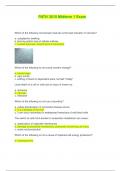
-
PATH 3610 Midterm 1 Exam | Answered with complete solutions
- Exam (elaborations) • 49 pages • 2024
-
Available in package deal
-
- $27.49
- + learn more
PATH 3610 Midterm 1 Exam | Answered with complete solutions Which of the following microscopic features is the best indicator of necrosis? a. cytoplasmic swelling b. blurring and/or loss of cellular outlines c. nuclear pyknosis, karyorrhexis or karyolysis Which of the following is not a post-mortem change? a. hemorrhage b. rigor mortis c. settling of blood in dependent parts, termed "lividity" Local death of a cell or cells due to injury is known as: a. ischemia b. necrosis c. Infarctio...

-
Wolfpacc Endo Clues Questions with Correct Answers And Complete Solutions.
- Exam (elaborations) • 21 pages • 2024
-
- $13.99
- + learn more
Wolfpacc Endo Clues Questions with Correct Answers And Complete Solutions. What is pyknosis - -Nucleus turns into blobs d/t shrinkage What Ab(s) is/are a/w Type 1 DM - -Anti-islet cell, anti-GAD What is Grave's Disease - -Hyperthyroid: exophthalmos, pretibial myxedema, weight loss, tachycardia, dry skin What Ab(s) is/are a/w Grave's Disease - -Anti-TSHr What is Hashimoto's - -Hypothyroid: weight gain, bradycardia What Ab(s) is/are a/w Hashimoto's - -Anti-microsomal; anti-TPO What are ...
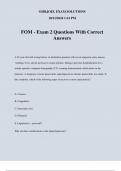
-
FOM - Exam 2 Questions With Correct Answers
- Exam (elaborations) • 164 pages • 2024
-
- $11.49
- + learn more
FOM - Exam 2 Questions With Correct Answers A 45-year-old with a long history of alcoholism presents with severe epigastric pain, nausea, vomiting, fever, and an increase in serum amylase. During a previous hospitalization for a similar episode, computed tomography (CT) scanning demonstrated calcifications in the pancreas. A diagnosis of acute pancreatitis superimposed on chronic pancreatitis was made. In this condition, which of the following types of necrosis is most characteristic? A. ...

-
MTM-Final Exam Basic Science
- Exam (elaborations) • 20 pages • 2024
-
- $9.49
- + learn more
MTM-Final Exam Basic Science Ionized forms like A- and BH+ are ________ and ______ diffusible across membrane water; poorly generic equation used to calculate week acidic and basic drugs 10 ^(pka-pH) = protonated/unprotonated equation to calculate weak acidic drugs 10^(pka-pH) = [nonionized(HA)]/[ionized(A-)] equation to calculate weak basic drugs 10^(pka-pH) = [ionized (BH+)]/[nonionized(B0] if the pka and pH difference is 1 or -1: ionization is 90% or 10% if the pka and pH differe...
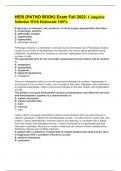
-
HESI (PATHO BOOK) Exam Fall 2022. Complete Solution With Rationale 100%
- Exam (elaborations) • 63 pages • 2024
-
- $18.99
- + learn more
HESI (PATHO BOOK) Exam Fall 2022. Complete Solution With Rationale 100% A decrease in workload, use, pressure, or blood supply appropriately describes: A. physiologic atrophy. B. pathologic atrophy. C. hypertrophy. D. hyperplasia. B. pathologic atrophy. Pathologic atrophy is a decrease in cell size due to decreased use. Physiologic atrophy usually occurs early in development; for example, the thymus gland atrophies during childhood. Hypertrophy is an increase in cell size. Hyperplasia...
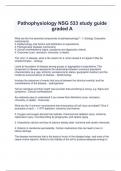
-
Pathophysiology NSG 533 study guide graded A
- Exam (elaborations) • 15 pages • 2024
-
Available in package deal
-
- $11.49
- + learn more
What are the five essential components of pathophysiology? - 1. Etiology (Causative mechanisms) 2. Epidemiology (risk factors and distribution in populations) 3. Pathogenesis (disease mechanism) 4. clinical manifestations (signs, symptoms and diagnostic criteria) 5. Outcomes (cure, remission, chronicity, or death) The "why" of disease- what is the reason for it- what caused it to happen? May be simple/complex. - etiology Looks at the pattern of disease among groups or aggregates or ...

Study stress? For sellers on Stuvia, these are actually golden times. KA-CHING! Earn from your study resources too and start uploading now. Discover all about earning on Stuvia


